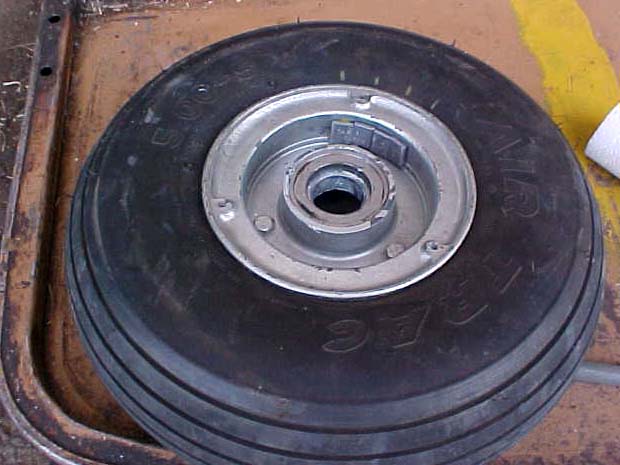Nose wheel shimmy
When experiencing nose wheel shimmy, here is a list of what to look for:
1. Tire itself (no flat spots?), wheel bearing not overly loose or worn? The single bearing wheel should feel a little loose, that is ok, but if you can move the tire by an inch to the left or right, that is not ok. Tire pressure is about 17 pounds per square inch. Too much and too little pressure makes the wheel more prone for shimmy. If possible have the wheel balanced. A static wheel balancer will do.
2. Nut cracker linkages. The bolts should be tight enough to not allow for any play. If the bolts are tight and you are still experiencing play in the linkages, check the bushings, they might be worn, - use new bolts.
3. Steering collar of the strut. You should not be able to move the collar up and down on the strut. There are shims for adjustments.
4. The steering socket ball. It is best to have it replaced at any sign of wear. (see also Steering)
5. Check for looseness of the steering rod in the steering column. Sometimes the lower bushing of the steering column is worn .- this feels like extra play in the Heim bearing of the steering rod. It is either way, or both. (PushRodBearings)
Everything within the steering should be working smoothly but without any click clack play.
Best to check is it either by lowering the tail with weights or a helper and rocking the linkages back and forth, or by having a helper put slight pressure on the controls inside the plane, while you are watching and feeling. The helper should just gently go back and forth with the controls. Little is a lot here. If you do the tests with a helper, the nose should be on the ground.
Hartmut
In addition to the items listed by Hartmut, you need to check the following items inside the airplane: (while the weight is off the nose gear) chain and sprockets for excessive looseness (there should be about a maximum of 1/2 inch of up and down play in the chain between the sprockets on the column)
Control column for up and down play - there should be none (check it with a good size screw driver, being careful not to damage the upper bushing, by prying between the quadrant (item 40 figure 21 page 29 of Ercoupe parts catalog) and the outer control column (item 35 same picture). Vertical play is limited to .003, so if you can see any, it is too much.
Play in the nose steering push rod (item 33 of the above picture) bearing to control column also when checking the steering collar on the nose strut for up and down play, check the collar and sleeve (Item 4 and 5 of figure 14 page 18 of parts catalog) for lateral play on the nose strut (there should be none)
I would also ask if this occurred suddenly, or gradually got worse over time. As bad as it seems, something should have most likely been fixed/replaced at the last annual.
Lynn Nelsen
Balancing the wheel
The 5.00X5 nose wheel has enough surface on the rim that balancing weights can be fitted.

The rim for the 5.00X4 tire is narrower in diameter with little surface to fit weights. Plus the surface is slightly tilted.

It would need more weights added for the same effect due to the smaller diameter. Sometimes theres is just not enough room to do so. Investigation showed that the rim is most likely balanced in itself and the imbalance comes from either the tube or the tire.

The imbalance can be cured by gluing a one ounce tire patch into the tire. To do so find the imbalance, mark the tire and rim, fit the weight maybe first without glue and check whether it fixed the problem. Then use strong cement to fit the patch permanently.




Joe